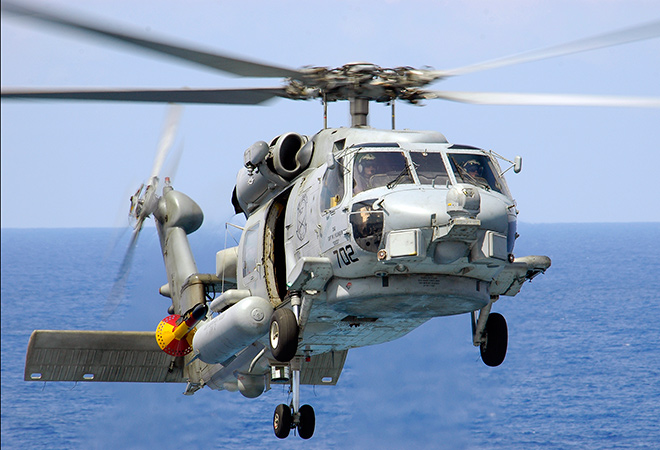
At the second US-India 2+2 Ministerial Dialogue slated for 18 December in Washington DC, US-India defence ties will be a central focal point. At the meeting, both countries are expected to ink the INR 17,500-crore deal for 24 Lockheed Martin-Sikorsky MH-60R naval helicopters, aimed at strengthening the Indian Navy’s “anti-submarine and anti-surface warfare and surveillance capabilities.”
Another procurement expected to be furthered, would be the recent US State Department clearance of the sale to India of up to thirteen MK 45 5 inch/62 caliber (MOD 4) naval guns and three thousand five hundred D349 Projectile, 5”/54 MK 92 MOD 1 Ammunition at an estimated cost of USD 1.0210 billion. As per the US Defence Security Cooperation Agency, the transfer is also aimed at enhancing the Indian Navy’s “capability to conduct antisurface warfare and anti-air defense missions while enhancing interoperability with U.S. and other allied forces.” The apparent US intent for India’s naval build-up is also often reciprocated, as the Indian Ministry of Defence’s Defence Acquisition Council (DAC) recently cleared the decks for six additional Boeing P-8I long-range maritime surveillance and anti-submarine aircraft. With eight already in service and another four due for delivery in 2020-21, India has adopted its P-8I fleet “equipped with a Magnetic Anomaly Detector (MAD) for detection of subsurface vessels.”
This impetus of US-India defence trade to India’s naval capacity-building has been towards Washington’s export of Mahanian thinking to New Delhi.
American export of Mahanian thought via capacity building
Alfred Thayer Mahan, perhaps the most celebrated naval historian of the 19th century has the less-known distinction of being a “reckless and almost comical” seaman who struggled to keep US ships straight on the high seas. As a naval strategist and historian, however, his seminal work The Influence of Sea Power Upon History, 1660-1783, continues to inform the centrality of naval power in American power projection. Mahan’s postulations were at the core of the US’ rise as a naval power in the 19th century, out to expand American commerce. In contemporary times of the US-led liberal order, Mahan’s influence over the US Navy – and its civilian principals – has translated into the American policing of sea lanes of communication as the normative prerequisite for free flow of commerce.
In the United States’ evolving geopolitical competition with China as well, Mahanian thinking is apparent. Moving away from the post-9/11 land-air wars in the Middle East, the Barack Obama administration put in force the ‘Pivot to Asia’ policy. The same chiefly encompassed stepping up engagement with the US ‘hub and spokes’ alliance partners in Asia, rebalancing the US Navy’s assets in the Pacific 60:40 away from the Persian Gulf, and developing the Air-Sea Battle (ASB) concept in response to Chinese Anti-Access, Area Denial (A2AD) strategies.
Under the Donald Trump administration’s Indo-Pacific strategy, there is considerable continuity in that thinking. In face of China’s naval build-up, Trump has built on the US Navy’s Nimitz Class fleet of 10 aircraft carriers by initiating the induction of the next-generation USS Gerald R Ford. Additionally, even amidst Congressional gridlock, the Trump administration has prioritised the US Navy’s USD 22.2 billion bid for nine ‘Block V’ Virginia Class fast attack submarines, and has been a vocal supporter of the US Navy’s plan to reach “a 355-ship fleet by the early FY2050s, potentially quicker with an aggressive investment of resources."
In then cultivating India as a “balancer” to China, the Indo-Pacific calculus seeks to marry the destinies of the Indian Ocean region to that of the East China Seas – which is expected to be the fulcrum of a possible US-China great power conflict. In that vein, the American intent to oversee India’s naval build-up constitutes its export of Mahanian thinking towards New Delhi gradually assuming the role of a regional goods provider in the Indian Ocean. Concurrently, this would help the US “share the burden” with India, and reduce “the strain on U.S. forces” in favour of more focused deployments in the Western Pacific.
The discussed US-led capacity building has arguably also translated into India gradually assuming a more active role. For instance, over the years, India has now become the largest – second only to the US itself, operator of P-8I maritime surveillance aircrafts. Underpinned with this capability, in December 2018, India launched the Information Fusion Centre – Indian Ocean Region (IFC-IOR) in Gurgaon. Set to host nearly two dozen liaison officers of partner nations, the IFC-IOR aims to “engage with partner nations and multi-national maritime constructs to develop comprehensive maritime domain awareness and share information on vessels of interest.”
Apart from such actions – arguably reflective of American “socialisation” of India – in the Indian Ocean, New Delhi has sought to diversify its alignments.
China in the Indian Ocean, and American dependability in question
Two years into the Trump presidency, it is apparent that blatant transactionalism in American foreign policy is less of an aberration, and increasingly the norm. With traditional partners in Western Europe and Northeast Asia, the Trump administration has linked inconsistencies on the trade front to its alliance commitments. With nascent partners like India, the Trump administration has had no qualms about adopting the economic and/or sanctions lever to exact congruence in policy towards Iran or Russia – nations deemed as being adversarial to the US.
Hence, there is recognition for the need to diversify alignments, to reduce the prospect of India’s evolving role in the Indian Ocean region being susceptible to American transactionalism. Alarmism aside, that concern does hold some credence given the fact that, the US is now India’s second-largest arms supplier and Indian armed forces today conduct “more joint military drills, tabletop exercises, and defense dialogues” with American forces than with any other country.
Moreover, irrespective of American prodding, it is also in India’s interest to assume a heightened naval role, given an increase in Chinese activity in the Indian Ocean region. At the core of India’s response is indigenous capacity-building to narrow its inventory deficit with China. On destroyers and submarines, China leads India by factors of about 2:1 and 4:1 respectively. This differential in capability has also translated into heightened Chinese activity in the Indian Ocean region – for which it is a crucial maritime highway overseeing a considerable share (nearly 80 percent) of its energy imports from the Middle East. Since 2013, there have been about eight reported sightings of Chinese submarines in the Indian Ocean. Recently, citing a case from September 2019, when the Indian Navy successfully repelled a Chinese vessel near the Andaman and Nicobar Islands, India’s Chief of Naval Staff Admiral Karambir Singh deemed his force’s intent to “closely” monitor China’s footprint as a priority.
Rising Chinese activity in the Indian Ocean and emerging questions over American dependability, however, also necessitate for India to diversify its alignments by seeking other like-minded partners.
Cultivating partners that have real skin in the game
The Modi dispensation’s reconfiguration of “strategic autonomy” into strategic alignments – attainable “through strengthened partnerships instead of avoiding partnerships”, permits multiple issue-based alignments. The same is apparent in India’s evolving role in the Indian Ocean, where like-minded partners are being identified.
At a recent event hosted by the Observer Research Foundation, French Navy Chief Admiral Christophe Prazuck revealed that India and France are in discussions for holding Joint Patrols in the Indian Ocean. If the same materialises, this would signify a departure from India’s position of conducting only Coordinated Patrols (CORPAT) – far from Joint Patrols, with maritime neighbours. Moreover, in the past, India has also turned down offers from “several senior U.S. military officers” on US-India Joint Patrols. Opting to hold joint patrols with France makes sense, as one may argue it has real skin in the game since the Southern Indian Ocean – home to overseas French territories, is also a “question of sovereignty” for Paris.
Similarly, India is in talks to ink logistics services agreements with Japan and Australia to further maritime security cooperation. Lastly, in identifying more like-minded partners, India is set to host its largest multilateral exercise next year. With 41 nations invited, the MILAN exercise will aim “to hone interoperability – a key shift from the past where the MILAN series has been seen as more of a cultural and academic exchange.” While the scale is not expected to match the US-organised RIMPAC exercise, with MILAN, India is expected to bring together contentious pairs like Iran and Israel, and Russia and the US.
In summation, although India’s adoption of American Mahanian thinking on naval power is apparent, New Delhi is keen on diversifying its alignments towards a sustained role in the Indian Ocean.
The views expressed above belong to the author(s). ORF research and analyses now available on Telegram! Click here to access our curated content — blogs, longforms and interviews.




 PREV
PREV


